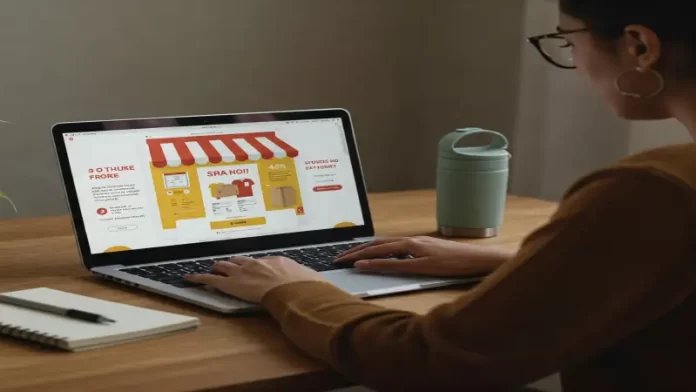Starting a dropshipping business with no money. Sounds like the ultimate dream, right? Launching an online store, selling products, making bank… all without spending a single rupee or dollar upfront. It’s the headline that grabs everyone.
Can you literally start with absolutely zero, zilch, nada in your pocket? Probably not. There are always potential small costs maybe a minimal business registration fee depending on where you are, the cost of your internet connection, maybe needing a tiny buffer for unforeseen issues. And crucially, what you don’t spend in cash, you will spend in time, effort, and sweat equity. Lots of it.
However! Can you start a dropshipping business with extremely minimal capital, leveraging free tools, platforms, and organic strategies to get the ball rolling? Absolutely YES. Forget needing thousands upfront. With the right approach, focusing on free resources and smart, organic growth, you can definitely lay the foundation for your dropshipping empire without breaking the bank.
So, lets reframe this. We’re talking about how to start dropshipping on a shoestring budget, leaning heavily on free methods, especially at the beginning. Ready to learn how to bootstrap your way into e-commerce? Lets get into it.
Table of Contents
Dropshipping Dreams on a Dime: Your Low-Budget Launch Guide
First off, what is dropshipping, really? Simple version: You set up an online storefront (or presence). A customer buys something from you. You take their money, then you place the order with your supplier (often at a lower, wholesale price). The supplier ships the product directly to the customer. You never handle the inventory yourself. Your profit is the difference between what the customer paid you and what you paid the supplier. Cool model, right?

Now, how do we do this without a hefty investment? It’s all about strategic choices and focusing on free resources initially.
Step 1: Niche Hunting (Cost: ₹0 / $0)
Finding the right niche is critical. Don’t just sell everything. Why? A focused niche helps you target your marketing, build authority, and connect with a specific audience. How to do it for free?
- Google Trends: See what people are searching for and if interest is rising or falling.
- Social Media Exploration: Browse Instagram hashtags, TikTok trends, Facebook groups, Pinterest boards, and Reddit subreddits related to your interests. What problems are people discussing? What products are they raving about (or complaining about)?
- Marketplace Browse: Look at best-sellers and trending items on Amazon, eBay, Flipkart, Etsy, etc. What categories seem popular but maybe underserved in a specific way?
- Your Own Interests: What are you passionate or knowledgeable about? It makes content creation much easier and more authentic. You need good understanding of your chosen market.
Step 2: Finding Your Suppliers (Cost: ₹0)
Once you have a niche, you need products and suppliers who dropship. Why? Reliable suppliers are the backbone of your business. Bad suppliers = unhappy customers = failed business. How to find them for free?
- Major Platforms: AliExpress is the classic starting point (huge variety, ships globally). CJ Dropshipping is another popular option, often with better shipping times. Spocket focuses on US/EU suppliers (often has free trial/plan limits).
- Search Engines: Use terms like “[niche] dropshipping supplier,” “[product] wholesaler,” “supplier directory free.”
- Local Suppliers (Potential): Depending on your niche and location, you might find local manufacturers or distributors willing to dropship. This can sometimes mean faster shipping for local customers. Reach out and ask!
- Vetting is Crucial: Don’t just pick the first one. Check reviews, order samples if possible (this might cost a little, but is wise), communicate with them about shipping times and processes. Finding suppliers take time and diligence.
Step 3: Choosing Your Selling Platform (Cost: ₹0 – ₹ Very Low Initially)
This is where you’ll list products and customers will buy. Why? You need a place to conduct transactions. Low-cost/free options:
- Marketplaces:
- eBay/Amazon/Flipkart: You leverage their massive existing traffic. Downside: Hefty competition, listing fees, selling fees cut into margins, less brand control. But, no upfront website cost.
- Facebook Marketplace/Instagram Shopping: Can work for certain products, leverages social reach. Policies on dropshipping can be strict or unclear, check carefully.
- E-commerce Platform Free Trials:
- Shopify: The giant. Offers a free trial (usually 3 days then a low introductory rate for months). Lets you build a professional-looking store easily. Eventual Cost: Monthly subscription after trial/intro offer.
- WooCommerce (with WordPress): The software itself is free and open-source. You’d need hosting (paid), but some hosts offer very cheap initial plans. Can use free themes/plugins. More technical setup required.
- Social Media Platforms: Focus entirely on building an audience on Instagram, TikTok, or Pinterest and directing them (via Linktree etc.) maybe to a simple checkout link or marketplace listing. Requires strong content game.
- Simple Landing Pages: Some tools offer free tiers for basic landing pages, maybe enough for a single product initially.
Step 4: Building Your Brand Identity (Cost: ₹0 – ₹ Very Low)
Even without a fancy website, you need a brand. Why? It builds trust and differentiates you. A business with no identity feels sketchy. How to do it cheap?
- Brand Name: Choose something memorable and relevant. Check if social media handles are available.
- Logo: Use free tools like Canva to design a simple, clean logo. Don’t overthink it initially.
- Consistency: Use the same name, logo, and general vibe across all platforms you use. Building a brand, consistency is key for recognition.
Step 5: Marketing – The Organic Hustle (Cost: ₹0)
This is where your time becomes the main investment. Paid ads are out if you have no money, so organic is your path. Why? Free traffic, builds long-term assets. How to market for free?
- Social Media Marketing: Choose 1-2 platforms where your target audience hangs out. Post consistently valuable content (not just product links!). Run contests, engage with followers, use relevant hashtags. Instagram Reels, TikTok videos, Pinterest Idea Pins are powerful.
- Content Marketing:
- Video: Start a YouTube channel or TikTok account reviewing products, showing them in use, offering niche tips. Video builds trust fast.
- Blogging (Free Platforms): Use Medium, LinkedIn Articles, or even create a free blog on platforms like Blogger to write helpful articles related to your niche, subtly weaving in product mentions (check platform rules on affiliate/dropship links).
- SEO (Search Engine Optimization): If using marketplaces or free blogging platforms, learn basic SEO to help your listings/articles get found in search results. Use relevant keywords in titles and descriptions. It’s a long game but powerful.
- Community Engagement: Participate genuinely in relevant Facebook groups, forums (Reddit, Quora). Answer questions, offer advice. Build a reputation. Don’t spam links. Maybe mention your brand or link only when highly relevant and allowed. Its all about adding value first.
- Email Marketing (Free Tiers): Use free plans from services like Mailerlite or Sendinblue (now Brevo). Collect emails via social media or simple landing pages. Send newsletters with tips, updates, and occasional promotions.
Step 6: Handling Orders & Customer Service (Cost: Your Time)
Okay, you got a sale! Why? Smooth process = happy customer = potential repeat business/good reviews.
The basic flow:
- Customer orders and pays you via your chosen platform.
- You receive the notification and payment (minus platform fees).
- You immediately place the identical order with your supplier, paying their price.
- Crucially: You provide the customer’s shipping address to the supplier.
- Supplier ships the product to the customer. They should provide tracking info, which you relay to your customer.
- Customer Service: This is ALL YOU. Since you don’t control shipping, you must handle inquiries, complaints, tracking updates promptly and professionally. Be prepared for shipping delays or quality issues and have a plan (liaise with supplier, offer refunds/reshipments if necessary). Excellent service can save a potentially bad situation. Poor service guarantees failure.
Step 7: The Less Fun Stuff – Legal & Financials (Potential Minimal Costs)
This is where “literally zero money” often hits a snag. Why? Legitimacy and staying out of trouble.
- Business Registration: Depending on your location, there could be small fees. Research local requirements. Operating totally under the radar is risky.
- Taxes: You’ll need to understand and pay income tax on your profits. Keep records!
- Potential Buffer: What if a customer needs a refund before the payment from the platform fully clears to you? What if you need to pay the supplier before the customer’s money is fully available? Having even a small buffer ($50-$100) can prevent cash flow issues right at the start. Refunds happen, its part of business.
- Platform Payouts: Understand how and when your chosen platform pays you. There’s often a delay.
The Reality Bites: Challenges of No-Budget Dropshipping
Starting lean is possible, but let’s not sugarcoat the challenges:
- Time Sink: Organic marketing takes a lot of consistent effort before showing results. Months, potentially.
- Thin Margins: Competition is fierce. Finding products with good profit margins after fees and potential supplier costs can be tough. You often need volume.
- Supplier Reliance: You’re dependent on suppliers for product quality and shipping speed. Choose wisely! One bad supplier can wreck your reputation.
- Customer Service Load: You handle all customer interactions without handling the product. This requires excellent communication skills.
- Scaling Difficulties: Relying purely on free methods makes scaling up harder and slower than using paid ads or premium tools. You dont need no huge budget, but reinvesting profits is key later.
So, Can You Really Start With Nothing?
Let’s circle back. Starting dropshipping with absolutely zero cash is highly unlikely and probably not advisable due to small potential fees and the need for a tiny buffer. But starting with extremely low investment, leveraging free trials, organic marketing, and your own hard work? Yes, that’s achievable.
It’s a grind, especially at first. Marketing organically, patience becomes your greatest virtue. You need to be resourceful, persistent, and focused on providing genuine value. Don’t expect overnight riches. Expect to learn a ton, make mistakes, and work hard. Building anything worthwhile take time.
But if you’re willing to put in the effort and approach it smartly, dropshipping can be your entry point into the world of e-commerce, even when funds are tight. Just manage your expectations, focus on the free strategies outlined here, and prepare to hustle! Good luck!

